trip VOLVO S60 2018 Owner´s Manual
[x] Cancel search | Manufacturer: VOLVO, Model Year: 2018, Model line: S60, Model: VOLVO S60 2018Pages: 396, PDF Size: 9.4 MB
Page 4 of 396
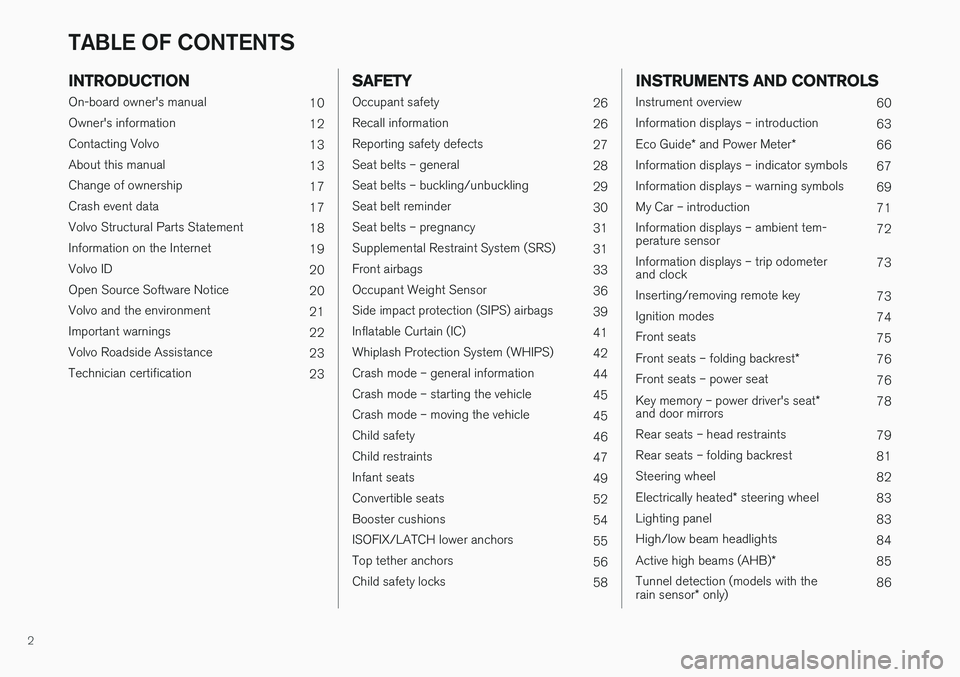
2
INTRODUCTION
On-board owner's manual10
Owner's information 12
Contacting Volvo 13
About this manual 13
Change of ownership 17
Crash event data 17
Volvo Structural Parts Statement 18
Information on the Internet 19
Volvo ID 20
Open Source Software Notice 20
Volvo and the environment 21
Important warnings 22
Volvo Roadside Assistance 23
Technician certification 23
SAFETY
Occupant safety26
Recall information 26
Reporting safety defects 27
Seat belts – general 28
Seat belts – buckling/unbuckling 29
Seat belt reminder 30
Seat belts – pregnancy 31
Supplemental Restraint System (SRS) 31
Front airbags 33
Occupant Weight Sensor 36
Side impact protection (SIPS) airbags 39
Inflatable Curtain (IC) 41
Whiplash Protection System (WHIPS) 42
Crash mode – general information 44
Crash mode – starting the vehicle 45
Crash mode – moving the vehicle 45
Child safety 46
Child restraints 47
Infant seats 49
Convertible seats 52
Booster cushions 54
ISOFIX/LATCH lower anchors 55
Top tether anchors 56
Child safety locks 58
INSTRUMENTS AND CONTROLS
Instrument overview 60
Information displays – introduction 63
Eco Guide * and Power Meter *
66
Information displays – indicator symbols 67
Information displays – warning symbols 69
My Car – introduction 71
Information displays – ambient tem- perature sensor 72
Information displays – trip odometerand clock 73
Inserting/removing remote key 73
Ignition modes 74
Front seats 75
Front seats – folding backrest *
76
Front seats – power seat 76
Key memory – power driver's seat *
and door mirrors 78
Rear seats – head restraints 79
Rear seats – folding backrest 81
Steering wheel 82
Electrically heated * steering wheel
83
Lighting panel 83
High/low beam headlights 84
Active high beams (AHB) *
85
Tunnel detection (models with the rain sensor * only) 86
TABLE OF CONTENTS
Page 5 of 396
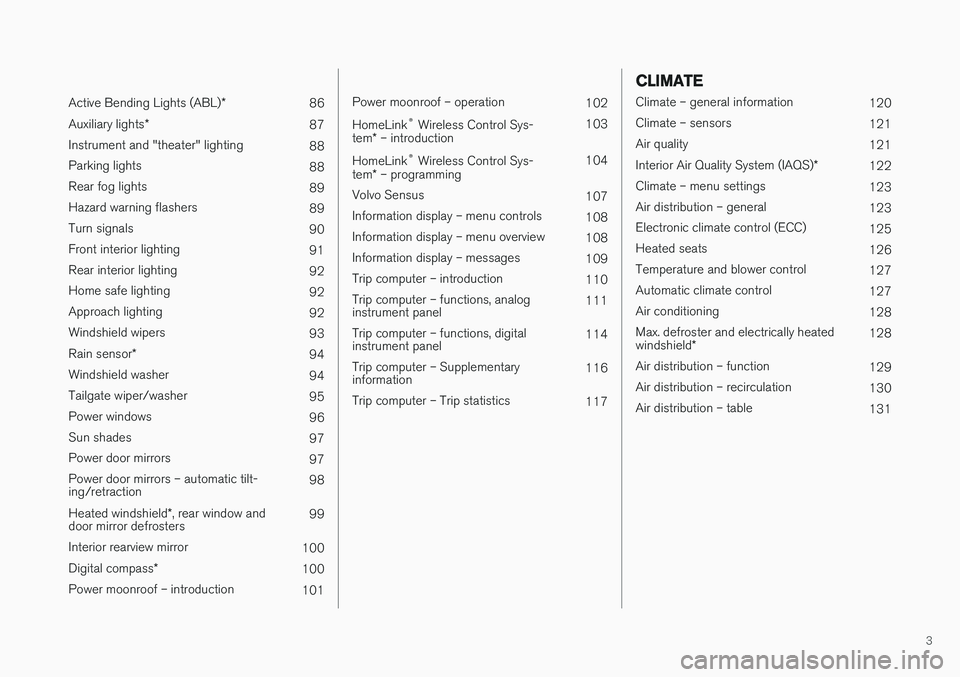
3
Active Bending Lights (ABL)*
86
Auxiliary lights *
87
Instrument and "theater" lighting 88
Parking lights 88
Rear fog lights 89
Hazard warning flashers 89
Turn signals 90
Front interior lighting 91
Rear interior lighting 92
Home safe lighting 92
Approach lighting 92
Windshield wipers 93
Rain sensor *
94
Windshield washer 94
Tailgate wiper/washer 95
Power windows 96
Sun shades 97
Power door mirrors 97
Power door mirrors – automatic tilt- ing/retraction 98
Heated windshield *, rear window and
door mirror defrosters 99
Interior rearview mirror 100
Digital compass *
100
Power moonroof – introduction 101
Power moonroof – operation102
HomeLink ®
Wireless Control Sys-
tem * – introduction 103
HomeLink ®
Wireless Control Sys-
tem * – programming 104
Volvo Sensus 107
Information display – menu controls 108
Information display – menu overview 108
Information display – messages 109
Trip computer – introduction 110
Trip computer – functions, analog instrument panel 111
Trip computer – functions, digitalinstrument panel 114
Trip computer – Supplementaryinformation 116
Trip computer – Trip statistics 117
CLIMATE
Climate – general information120
Climate – sensors 121
Air quality 121
Interior Air Quality System (IAQS) *
122
Climate – menu settings 123
Air distribution – general 123
Electronic climate control (ECC) 125
Heated seats 126
Temperature and blower control 127
Automatic climate control 127
Air conditioning 128
Max. defroster and electrically heated windshield * 128
Air distribution – function 129
Air distribution – recirculation 130
Air distribution – table 131
Page 8 of 396
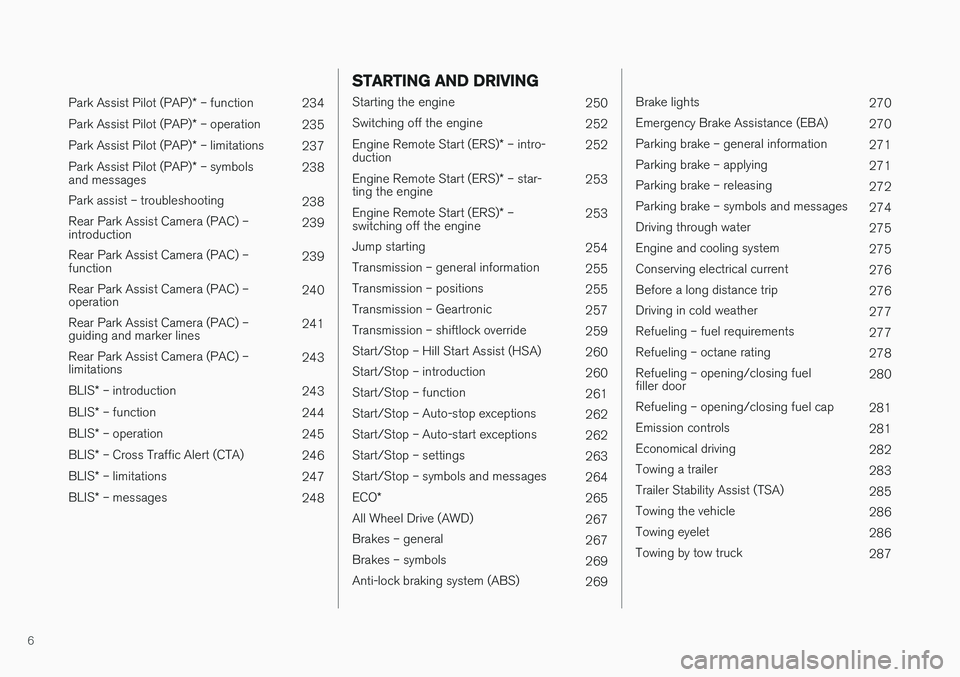
6
Park Assist Pilot (PAP)* – function
234
Park Assist Pilot (PAP) * – operation
235
Park Assist Pilot (PAP) * – limitations
237
Park Assist Pilot (PAP) * – symbols
and messages 238
Park assist – troubleshooting 238
Rear Park Assist Camera (PAC) – introduction 239
Rear Park Assist Camera (PAC) –function 239
Rear Park Assist Camera (PAC) –operation 240
Rear Park Assist Camera (PAC) –guiding and marker lines 241
Rear Park Assist Camera (PAC) –limitations 243
BLIS * – introduction
243
BLIS * – function
244
BLIS * – operation
245
BLIS * – Cross Traffic Alert (CTA)
246
BLIS * – limitations
247
BLIS * – messages
248
STARTING AND DRIVING
Starting the engine
250
Switching off the engine 252
Engine Remote Start (ERS) * – intro-
duction 252
Engine Remote Start (ERS) * – star-
ting the engine 253
Engine Remote Start (ERS) * –
switching off the engine 253
Jump starting 254
Transmission – general information 255
Transmission – positions 255
Transmission – Geartronic 257
Transmission – shiftlock override 259
Start/Stop – Hill Start Assist (HSA) 260
Start/Stop – introduction 260
Start/Stop – function 261
Start/Stop – Auto-stop exceptions 262
Start/Stop – Auto-start exceptions 262
Start/Stop – settings 263
Start/Stop – symbols and messages 264
ECO *
265
All Wheel Drive (AWD) 267
Brakes – general 267
Brakes – symbols 269
Anti-lock braking system (ABS) 269
Brake lights270
Emergency Brake Assistance (EBA) 270
Parking brake – general information 271
Parking brake – applying 271
Parking brake – releasing 272
Parking brake – symbols and messages 274
Driving through water 275
Engine and cooling system 275
Conserving electrical current 276
Before a long distance trip 276
Driving in cold weather 277
Refueling – fuel requirements 277
Refueling – octane rating 278
Refueling – opening/closing fuel filler door 280
Refueling – opening/closing fuel cap 281
Emission controls 281
Economical driving 282
Towing a trailer 283
Trailer Stability Assist (TSA) 285
Towing the vehicle 286
Towing eyelet 286
Towing by tow truck 287
Page 15 of 396
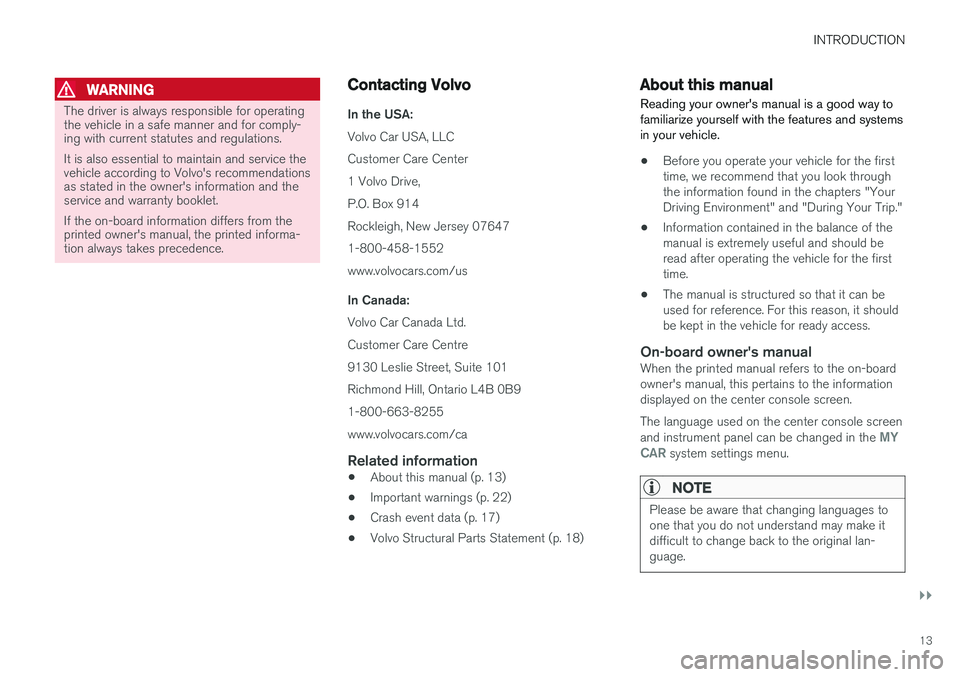
INTRODUCTION
}}
13
WARNING
The driver is always responsible for operating the vehicle in a safe manner and for comply-ing with current statutes and regulations. It is also essential to maintain and service the vehicle according to Volvo's recommendationsas stated in the owner's information and theservice and warranty booklet. If the on-board information differs from the printed owner's manual, the printed informa-tion always takes precedence.
Contacting Volvo
In the USA:Volvo Car USA, LLC
Customer Care Center 1 Volvo Drive,P.O. Box 914 Rockleigh, New Jersey 076471-800-458-1552www.volvocars.com/us In Canada: Volvo Car Canada Ltd. Customer Care Centre9130 Leslie Street, Suite 101Richmond Hill, Ontario L4B 0B91-800-663-8255www.volvocars.com/ca
Related information
• About this manual (p. 13)
• Important warnings (p. 22)
• Crash event data (p. 17)
• Volvo Structural Parts Statement (p. 18)
About this manual
Reading your owner's manual is a good way to familiarize yourself with the features and systemsin your vehicle.
• Before you operate your vehicle for the first time, we recommend that you look throughthe information found in the chapters "YourDriving Environment" and "During Your Trip."
• Information contained in the balance of themanual is extremely useful and should beread after operating the vehicle for the firsttime.
• The manual is structured so that it can beused for reference. For this reason, it shouldbe kept in the vehicle for ready access.
On-board owner's manualWhen the printed manual refers to the on-boardowner's manual, this pertains to the informationdisplayed on the center console screen. The language used on the center console screen and instrument panel can be changed in the
MY
CAR system settings menu.
NOTE
Please be aware that changing languages to one that you do not understand may make itdifficult to change back to the original lan-guage.
Page 64 of 396
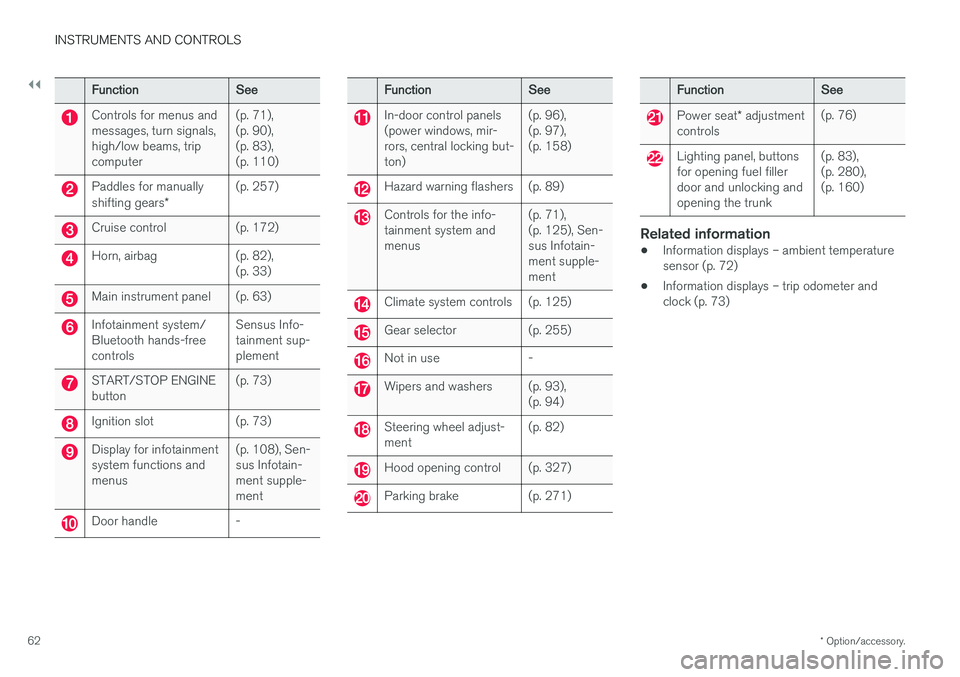
||
INSTRUMENTS AND CONTROLS
* Option/accessory.
62
Function See
Controls for menus and messages, turn signals,high/low beams, tripcomputer(p. 71),(p. 90),(p. 83),(p. 110)
Paddles for manually shifting gears
*(p. 257)
Cruise control (p. 172)
Horn, airbag (p. 82),
(p. 33)
Main instrument panel (p. 63)
Infotainment system/ Bluetooth hands-freecontrolsSensus Info-tainment sup-plement
START/STOP ENGINE button
(p. 73)
Ignition slot (p. 73)
Display for infotainment system functions andmenus(p. 108), Sen-sus Infotain-ment supple-ment
Door handle -
Function
See
In-door control panels (power windows, mir-rors, central locking but-ton)(p. 96),(p. 97),(p. 158)
Hazard warning flashers (p. 89)
Controls for the info- tainment system andmenus
(p. 71),(p. 125), Sen-sus Infotain-ment supple-ment
Climate system controls (p. 125)
Gear selector (p. 255)
Not in use -
Wipers and washers (p. 93),
(p. 94)
Steering wheel adjust- ment(p. 82)
Hood opening control (p. 327)
Parking brake (p. 271)
Function
See
Power seat* adjustment
controls (p. 76)
Lighting panel, buttons for opening fuel fillerdoor and unlocking andopening the trunk(p. 83),(p. 280),(p. 160)
Related information
•
Information displays – ambient temperature sensor (p. 72)
• Information displays – trip odometer andclock (p. 73)
Page 65 of 396
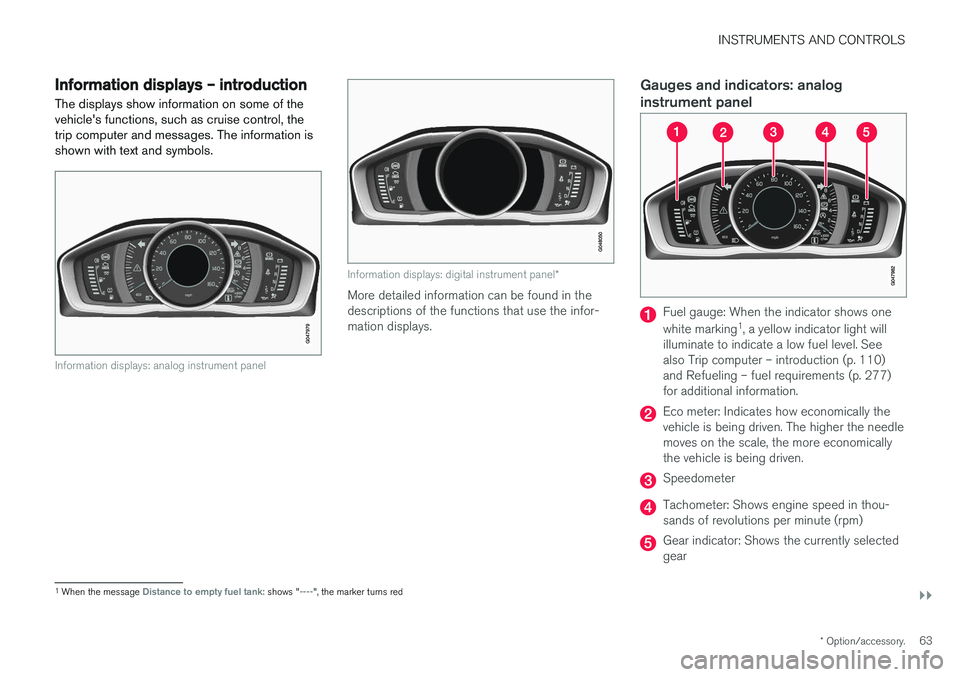
INSTRUMENTS AND CONTROLS
}}
* Option/accessory.63
Information displays – introduction
The displays show information on some of the vehicle's functions, such as cruise control, thetrip computer and messages. The information isshown with text and symbols.
Information displays: analog instrument panel
Information displays: digital instrument panel *
More detailed information can be found in the descriptions of the functions that use the infor-mation displays.
Gauges and indicators: analog instrument panel
Fuel gauge: When the indicator shows one white marking1
, a yellow indicator light will
illuminate to indicate a low fuel level. See also Trip computer – introduction (p. 110)and Refueling – fuel requirements (p. 277)for additional information.
Eco meter: Indicates how economically the vehicle is being driven. The higher the needlemoves on the scale, the more economicallythe vehicle is being driven.
Speedometer
Tachometer: Shows engine speed in thou- sands of revolutions per minute (rpm)
Gear indicator: Shows the currently selected gear
1 When the message Distance to empty fuel tank: shows "----", the marker turns red
Page 66 of 396
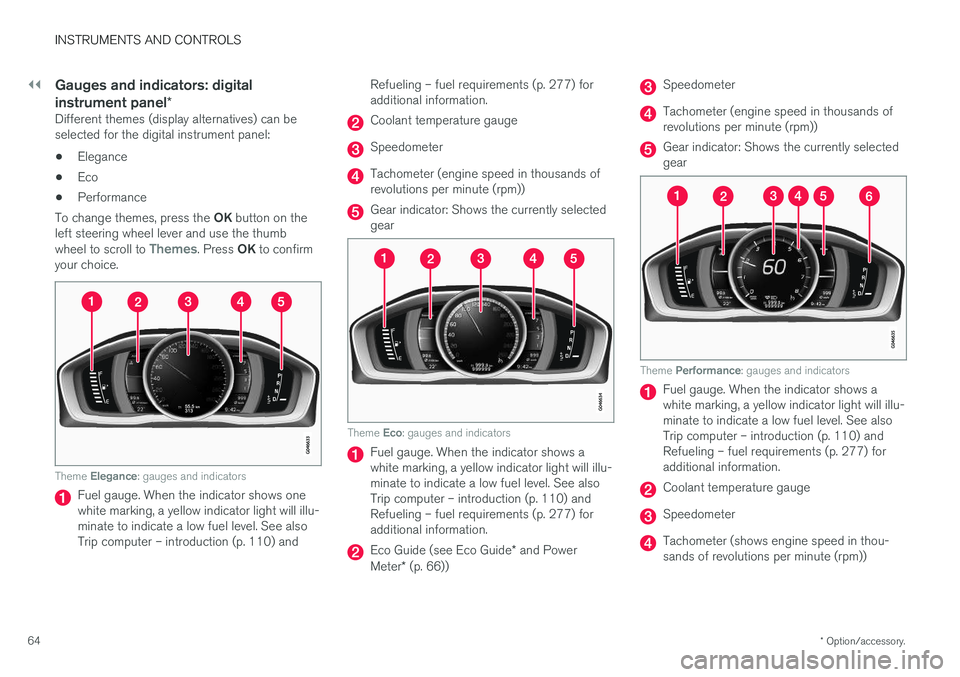
||
INSTRUMENTS AND CONTROLS
* Option/accessory.
64
Gauges and indicators: digital instrument panel *
Different themes (display alternatives) can be selected for the digital instrument panel:
• Elegance
• Eco
• Performance
To change themes, press the OK button on the
left steering wheel lever and use the thumb wheel to scroll to
Themes. Press OK to confirm
your choice.
Theme Elegance : gauges and indicators
Fuel gauge. When the indicator shows one white marking, a yellow indicator light will illu-minate to indicate a low fuel level. See alsoTrip computer – introduction (p. 110) and Refueling – fuel requirements (p. 277) foradditional information.
Coolant temperature gauge
Speedometer
Tachometer (engine speed in thousands of revolutions per minute (rpm))
Gear indicator: Shows the currently selected gear
Theme
Eco: gauges and indicators
Fuel gauge. When the indicator shows a white marking, a yellow indicator light will illu-minate to indicate a low fuel level. See alsoTrip computer – introduction (p. 110) andRefueling – fuel requirements (p. 277) foradditional information.
Eco Guide (see Eco Guide * and Power
Meter * (p. 66))
Speedometer
Tachometer (engine speed in thousands of revolutions per minute (rpm))
Gear indicator: Shows the currently selected gear
Theme Performance : gauges and indicators
Fuel gauge. When the indicator shows a white marking, a yellow indicator light will illu-minate to indicate a low fuel level. See alsoTrip computer – introduction (p. 110) andRefueling – fuel requirements (p. 277) foradditional information.
Coolant temperature gauge
Speedometer
Tachometer (shows engine speed in thou- sands of revolutions per minute (rpm))
Page 68 of 396
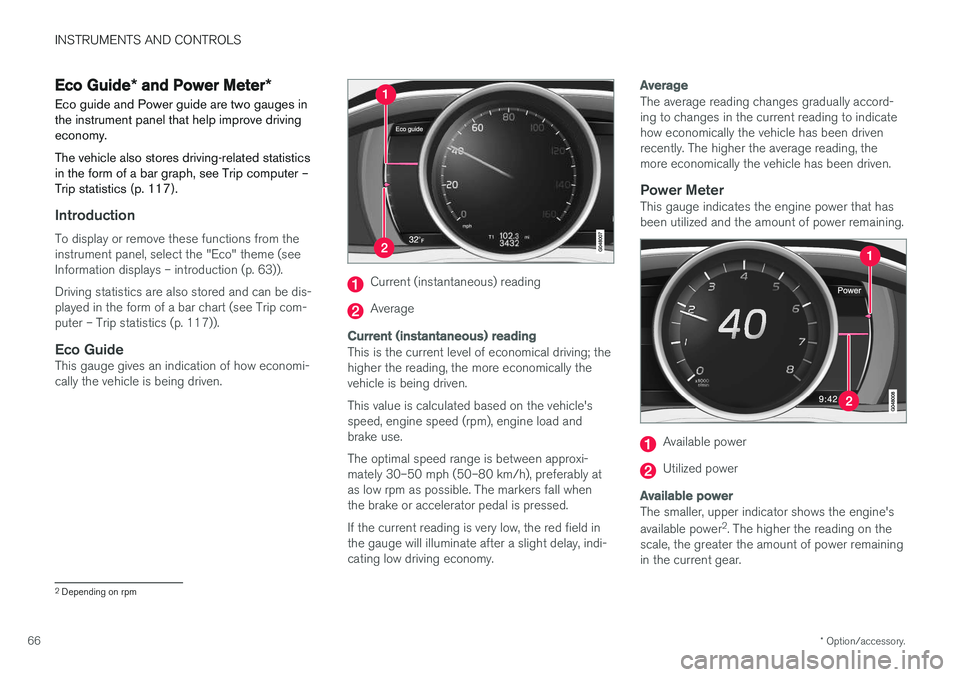
INSTRUMENTS AND CONTROLS
* Option/accessory.
66
Eco Guide * and Power Meter *
Eco guide and Power guide are two gauges in the instrument panel that help improve drivingeconomy. The vehicle also stores driving-related statistics in the form of a bar graph, see Trip computer –Trip statistics (p. 117).
Introduction
To display or remove these functions from the instrument panel, select the "Eco" theme (seeInformation displays – introduction (p. 63)). Driving statistics are also stored and can be dis- played in the form of a bar chart (see Trip com-puter – Trip statistics (p. 117)).
Eco GuideThis gauge gives an indication of how economi-cally the vehicle is being driven.
Current (instantaneous) reading
Average
Current (instantaneous) reading
This is the current level of economical driving; the higher the reading, the more economically thevehicle is being driven. This value is calculated based on the vehicle's speed, engine speed (rpm), engine load andbrake use. The optimal speed range is between approxi- mately 30–50 mph (50–80 km/h), preferably atas low rpm as possible. The markers fall whenthe brake or accelerator pedal is pressed. If the current reading is very low, the red field in the gauge will illuminate after a slight delay, indi-cating low driving economy.
Average
The average reading changes gradually accord- ing to changes in the current reading to indicatehow economically the vehicle has been drivenrecently. The higher the average reading, themore economically the vehicle has been driven.
Power MeterThis gauge indicates the engine power that hasbeen utilized and the amount of power remaining.
Available power
Utilized power
Available power
The smaller, upper indicator shows the engine's available power 2
. The higher the reading on the
scale, the greater the amount of power remaining in the current gear.
2 Depending on rpm
Page 75 of 396
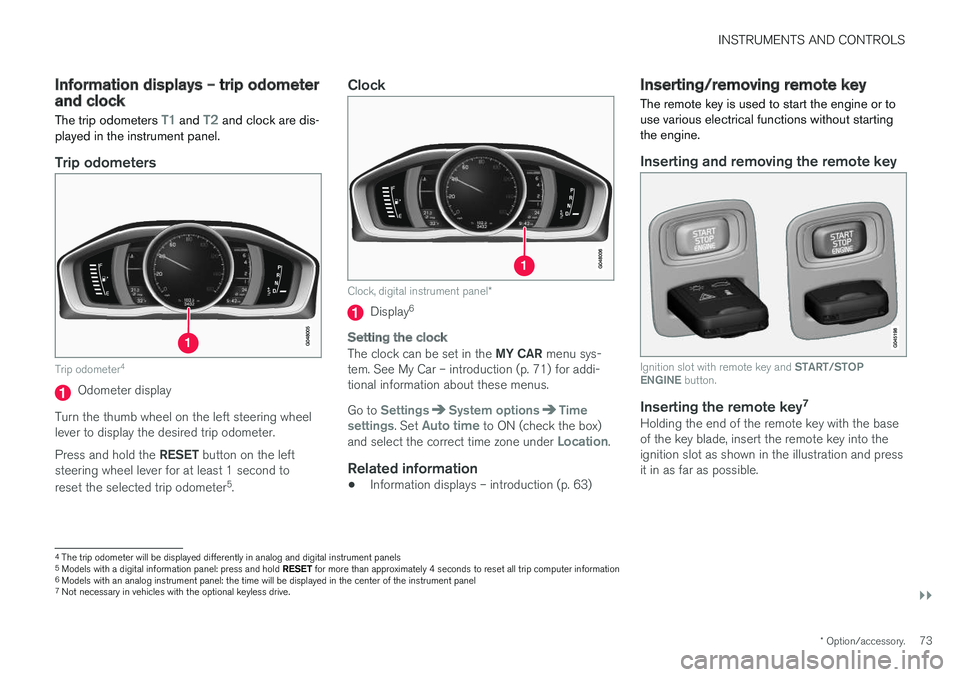
INSTRUMENTS AND CONTROLS
}}
* Option/accessory.73
Information displays – trip odometer and clock The trip odometers
T1 and T2 and clock are dis-
played in the instrument panel.
Trip odometers
Trip odometer 4
Odometer display
Turn the thumb wheel on the left steering wheel lever to display the desired trip odometer. Press and hold the RESET button on the left
steering wheel lever for at least 1 second to reset the selected trip odometer 5
.
Clock
Clock, digital instrument panel *
Display6
Setting the clock
The clock can be set in the
MY CAR menu sys-
tem. See My Car – introduction (p. 71) for addi- tional information about these menus. Go to
SettingsSystem optionsTime
settings. Set Auto time to ON (check the box)
and select the correct time zone under Location.
Related information
• Information displays – introduction (p. 63)
Inserting/removing remote key The remote key is used to start the engine or to use various electrical functions without startingthe engine.
Inserting and removing the remote key
Ignition slot with remote key and
START/STOP
ENGINE button.
Inserting the remote key 7Holding the end of the remote key with the base of the key blade, insert the remote key into theignition slot as shown in the illustration and pressit in as far as possible.
4
The trip odometer will be displayed differently in analog and digital instrument panels
5 Models with a digital information panel: press and hold RESET for more than approximately 4 seconds to reset all trip computer information
6 Models with an analog instrument panel: the time will be displayed in the center of the instrument panel
7
Not necessary in vehicles with the optional keyless drive.
Page 110 of 396
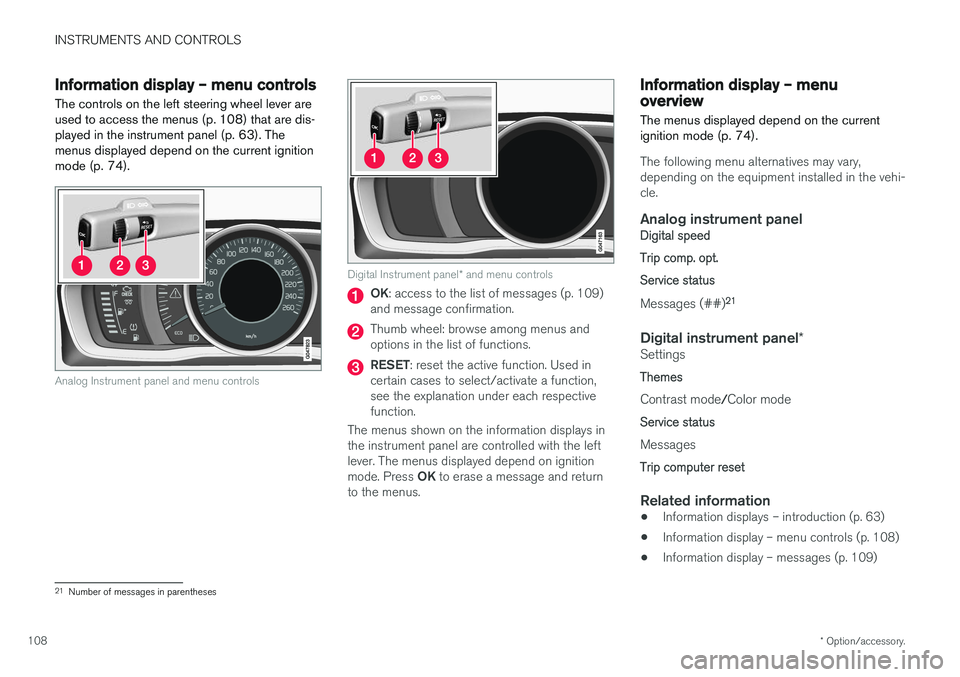
INSTRUMENTS AND CONTROLS
* Option/accessory.
108
Information display – menu controls
The controls on the left steering wheel lever are used to access the menus (p. 108) that are dis-
played in the instrument panel (p. 63). Themenus displayed depend on the current ignition
mode (p. 74).
Analog Instrument panel and menu controls
Digital Instrument panel * and menu controls
OK : access to the list of messages (p. 109)
and message confirmation.
Thumb wheel: browse among menus and options in the list of functions.
RESET : reset the active function. Used in
certain cases to select/activate a function, see the explanation under each respectivefunction.
The menus shown on the information displays inthe instrument panel are controlled with the leftlever. The menus displayed depend on ignition mode. Press OK to erase a message and return
to the menus.
Information display – menu overview
The menus displayed depend on the current ignition mode (p. 74).
The following menu alternatives may vary, depending on the equipment installed in the vehi-cle.
Analog instrument panelDigital speed Trip comp. opt.Service status
Messages (##) 21
Digital instrument panel
*Settings
Themes
Contrast mode /Color mode
Service status
Messages
Trip computer reset
Related information
• Information displays – introduction (p. 63)
• Information display – menu controls (p. 108)
• Information display – messages (p. 109)
21
Number of messages in parentheses